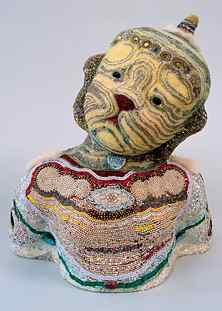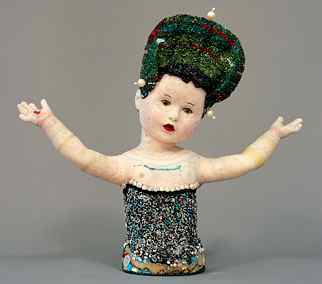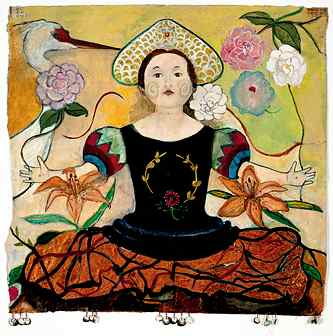Editor's note: The Bellevue Art Museum provided
source material to Resource Library for the following article or
essay. If you have questions or comments regarding the source material,
please contact the Bellevue Art Museum directly through either this phone
number or web address:
Sherry Markovitz: Shimmer,
Paintings and Sculptures 1979 - 2007
May 22 - September 7, 2008
As a mid-career retrospective
of renowned Seattle-based, mixed-media artist, Sherry Markovitz, this exhibition
is comprised of 41 pieces: 29 sculptural works (10 dolls, 5 gourds, 14 animals)
and 12 paintings.
Known for her evocative beaded assemblages, drawings, and
paintings, Markovitz intricately weaves through various themes and materials
in her multi-dimensional work. The artist is perhaps best known for her
beaded, richly-adorned papier-mâché animal head trophies and
dolls, which explore the realms of human expression, art and craft, life
and death, and metaphors of gender and identity. Her prominent use of beads
as a form of expression crosses cultural boundaries, touching on their historical
and symbolic use -- functional, ceremonial, and spiritual -- around the
world.
Born in 1947 in Chicago, Illinois, Seattle based artist,
Sherry Markovitz has spent years collecting beads, buttons, feathers, little
plastic Scotties, kewpie dolls, fake pearls, charms, etc. with a "wish
to turn dross into art." She makes her figures out of papier-mache
and reinforces with fiberglass and then covers with the above described
objects. Sherry Markovitz received her BA in Ceramics and Art Education
at the University of Wisconsin, Madison in 1969, WI, and received her MFA
in Printmaking from the University of Washington in 1975.
Markovitz's works are featured in numerous public and private
collections, including: The Corning Museum of Glass, NY; American Craft
Museum, NY; Mint Museum, Charlotte, NC; John Michael Kohler Art Center,
Sheboygan, WI; Seattle City Light 1% for Art Collection; Junior League,
Seattle; Seattle Art Museum; and Microsoft Corporation, Redmond, WA; among
others.
Sherry Markovitz: Shimmer has been organized and distributed
by the Museum of Art/Washington State University, Pullman, WA.
Related event
- Meet the Artist! - Friday, July 11 · 6:30 - 7:30
pm · FREE
- Free First Friday Lecture Series: Sherry Markovitz -
Adornment, Beads and Mixed Media Sculpture
Artist's statement
In 1981, I began the series of ornamented animal trophy
heads of deer, elk and moose and wild cats...they are beautiful images of
rebirth, the death somewhat masked by their beauty. They are also a feminization
of the traditionally male role as hunter, which has for centuries carried
an unspoken taboo for women.
- The most important aspect of my work is that it is circular,
not linear. I weave in and out of themes and materials, sometimes developing
an idea with new materials and ideas, sometimes returning to the simplicity
of paint and paper. I move back and forth between two and three dimensions.
The same symbols change their meaning over time, a symbol of loss in one
body of work becoming one of well being in another.
-
- My earliest paintings are of domestic and confined animals.
Landscapes of sheep, donkey and elephants speak of comfort and security,
which correspond to the death of my father. They are large, ambitious paintings,
some with beads and sequins. I then moved into the wilderness arena with
images of bears or deer animals that are often viewed as prey. The paintings
moved into sculpture, as they could no longer be contained in two dimensions.
-
- When my mother died in 1985, I returned home and began
a series of doll paintings. With leftover pieces of metal (from the building
of my house) I did a series in oil paintings on metal. They spoke about
loss and fragmentation. That period lasted about a year, the time it takes
to heal from a loss (according to the Talmud). The last of these works
still contained emptiness, but also fertility in their reference to flowers
and spring.
-
- The birth of my son in 1988 was a quiet and happy period.
I began to do simplified shapes using beads, but as monochromatic skins.
Gourds were cut up, reassembled, and beaded simply, accentuating their
sensuous curves and contours. The pieces were hung at unusual angles to
the wall, so that striving for the balance point became the key to their
success. I see these gourd works as having a spirit of gathering rather
than hunting. I am still working on these ideas and or forms in the sense
that I know I will come back to them.
-
- The previously two-dimensional dolls became sculptural
in 1998. These primarily positive memories of childhood were highly decorated
with a vast array of materials including flowers, shells, feathers and
old pieces of costume jewelry covering every surface. I was still making
beaded trophy heads as well as new abstract bulbous pieces which took their
shapes from oddly tied and sectioned balloons that I covered in papier-mach?
and then beaded entirely. I decided that it was an external expectation
that one should leave one idea and move onto the next, but that, still,
I needed my multiple languages of materials and ideas. It was a way of
expressing obsessive compulsion against quiet simplicity.
-
- Currently, I am back to painting on paper. Images of
female doll heads and bodies, stuffed animals, dresses, and iconic images
such as Howdy Doody, Charlie McCarthy, Mortimer Snurd and Emmett Kelly.
They refer to my earlier doll paintings, as well as trophy heads - being
just heads. Executed in water-based media mixed with egg, the material
allows for a sculptural dimension by a disregard for the sacredness of
the paper by allowing for wrinkles, yet maintaining a tactile pleasure
by building up a surface with thin layers of glazing. These paintings came
out of a sense of urgency, as a dream poking through the unconscious to
deliver a message.
-
- The aspect of collective memory refers to something people
of my generation all remember. For people of future generations these iconic
images become collectibles. "Collectibles" does, in fact, refer
to our collective memories. It is important that these works not be nostalgic
or sentimental, but offer a departure point for all of us to remember as
we face the future.
-
- - Sherry Markovitz, 2001

(above: Sherry Markovitz, Breasted Buddha, 2002-2003,
Beads, papier-mâché, mixed media, 15 x 13 x 9 inches. Collection
of Driek and Michael Zirinsky. Photo: Markovitz/Millett)

(above: Sherry Markovitz, Herself, 2005-2006, Beads,
papier-mâché, mixed media, 20.5 x 23.5 x 6.5 inches. Collection
of the Artist. Photo: Markovitz/Millett)

(above: Sherry Markovitz, Pocahantas, 2005-2006,
Foil, gouache, shells on paper, 30 x 30 inches. Collection of the Artist.
Photo: C.B. Bell)
RL readers may also enjoy
- Pacific Coast Painting: Alaska, California, Hawaii, Oregon,
Washington: 19th-21st Century
Read more articles and essays concerning this institutional
source by visiting the sub-index page for the Bellevue
Art Museum in Resource Library.
Search Resource
Library for thousands of articles and essays on American art.
Copyright 2008 Traditional Fine Arts Organization, Inc., an Arizona nonprofit corporation. All rights
reserved.



